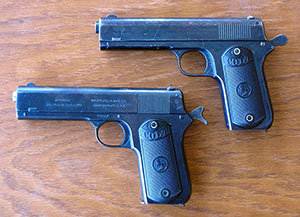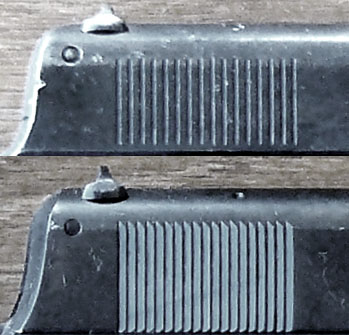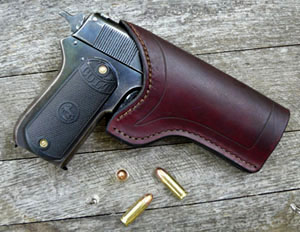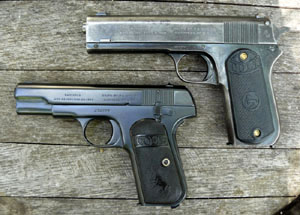|
The 1903 Colt .38 Automatic
Pocket Model
by Ed Buffaloe
In an effort to make an automatic pistol that would be a commercial success, The Colt’s Patent Firearms Manufacturing Company issued two new pistols in 1903. The first was the “Hammerless” Pocket Model in .32 caliber, which continued in production for 44 years and
had sales in excess of 500,000. The second was the .38 Automatic Pocket Model, which is often referred to by collectors today as the “1903 Pocket Hammer” to
distinguish it from the “Pocket Hammerless,” and which had a production run that spanned 25 years but with sales of only about 31,000 guns.
The .38 Pocket Model was essentially a 1902 Colt Automatic Pistol, Sporting Model, with the
barrel and slide shortened by one and a half inches, and was a direct descendant of the original Colt Automatic Pistol of 1900. Colt’s wanted to expand their line of automatic pistols, and thought a slightly smaller version of their pistol chambered for the powerful .38 auto cartridge
might sell. To call it a pocket model is a bit of a stretch, in my opinion, but it was certainly less unwieldy than its predecessors, and it was only a little larger than the .32 Pocket “Hammerless”.
 Bady states that preparations for manufacturing the .38 Pocket Model probably began early in 1903. The various
internal lockwork components, sights, hammer, barrel fittings, grip, magazine release, slide lock bar and takedown mechanism were all identical to that of the Sporting Model. “A substantial amount of the machining
and secondary operations on the slide, frame and barrel are the same for both pistols; these parts were probably run on an alternate lot basis through the tool and machining
setups. Preparation of forging dies and special machining setups peculiar to the Pocket Model required a few months work.” The first guns were probably ready for sale by December of 1903. Bady states that preparations for manufacturing the .38 Pocket Model probably began early in 1903. The various
internal lockwork components, sights, hammer, barrel fittings, grip, magazine release, slide lock bar and takedown mechanism were all identical to that of the Sporting Model. “A substantial amount of the machining
and secondary operations on the slide, frame and barrel are the same for both pistols; these parts were probably run on an alternate lot basis through the tool and machining
setups. Preparation of forging dies and special machining setups peculiar to the Pocket Model required a few months work.” The first guns were probably ready for sale by December of 1903.
Throughout the entire production of the .38 Pocket Model the right side of the slide was marked “AUTOMATIC COLT / CALIBRE 38 RIMLESS SMOKELESS”. The markings on the left side of
the slide mirror those of the 1902 Military Model, so I will not repeat them here. The early guns
had the spurless “stub” hammer (through 1908 and approximately serial number 24900), which was replaced with a spur hammer. The gun originally had 16 plunge milled slide serrations at the
rear of the slide, but early in 1906 (in the mid-17000 serial number range) they were changed to 19 triangular cut serrations like those that have been used on Colt automatic pistols ever since. There
are a few other minor variations that are documented in Sheldon’s book.
 The original design of 1900 had a safety
incorporated into the rear sight, but the design was flawed and Colt’s eventually dropped it. They didn’t bother trying to retrofit another safety mechanism onto the .38 Pocket Model, and I believe
that was detrimental to sales over time. When the .32 “Hammerless” Pocket Model came out it had both a manual safety and a grip safety, and people were much more comfortable carrying it with a
round in the chamber. Neither gun had a mechanism for holding the slide open after the last round was fired. The original design of 1900 had a safety
incorporated into the rear sight, but the design was flawed and Colt’s eventually dropped it. They didn’t bother trying to retrofit another safety mechanism onto the .38 Pocket Model, and I believe
that was detrimental to sales over time. When the .32 “Hammerless” Pocket Model came out it had both a manual safety and a grip safety, and people were much more comfortable carrying it with a
round in the chamber. Neither gun had a mechanism for holding the slide open after the last round was fired.
After the introduction of the two pocket pistols in 1903, Colt’s attention turned to trying to obtain a
lucrative military contract. Soon after the .38 Military Model failed to win approval by the U.S. military, the U.S. Ordnance Department decided U.S. handguns should be at least .45 caliber and
Colt’s had already begun development of the .45 auto cartridge. Future military guns were required to use the .45, so Colt’s and Browning focused on designing a .45 automatic pistol that
would meet the requirements of the military. Further development of .38 caliber automatics was shelved for 25 years. The Colt .38 Military Model and Pocket Model were both discontinued
around 1928--John Moses Browning had just passed away in 1926--and a year or so later the .38 super cartridge was introduced and a version of the Colt 1911A was chambered for it. The .38
Super cartridge is too hot to fire in the early Colt .38 automatics.
 I bought this old gun cheap because it was lacking grips. I ordered some plastic reproductions from Vintage Grips, as well as some screws. Vintage Grips makes a lot of grips but apparently no one there knows much about the old guns
. They sent me the wrong screws twice, and didn’t have escutcheons for this gun. The person I spoke with said they have two sizes of screws, and they just eyeball the
grips and send the screws that look to be the right size. Then I ordered some screws and escutcheons from ColtParts.Com. I was very careful to state that I needed
screws and escutcheons for the 1903 Pocket Model .38, but I still received a screw, escutcheon, and nut for a 1903 Pocket Model .32. I ended up paying $40 for four escutcheons and slim brass
screws with the wrong threads that were made for the .32. Then I cut the screws down to size and let the steel in the Colt frame cut new threads in the soft brass. At least now I have grips on the
gun and can take it out and shoot it. I’m still looking for the correct screws and a set of original grips. I bought this old gun cheap because it was lacking grips. I ordered some plastic reproductions from Vintage Grips, as well as some screws. Vintage Grips makes a lot of grips but apparently no one there knows much about the old guns
. They sent me the wrong screws twice, and didn’t have escutcheons for this gun. The person I spoke with said they have two sizes of screws, and they just eyeball the
grips and send the screws that look to be the right size. Then I ordered some screws and escutcheons from ColtParts.Com. I was very careful to state that I needed
screws and escutcheons for the 1903 Pocket Model .38, but I still received a screw, escutcheon, and nut for a 1903 Pocket Model .32. I ended up paying $40 for four escutcheons and slim brass
screws with the wrong threads that were made for the .32. Then I cut the screws down to size and let the steel in the Colt frame cut new threads in the soft brass. At least now I have grips on the
gun and can take it out and shoot it. I’m still looking for the correct screws and a set of original grips.
The magazine release is backward from modern pistol designs. You squeeze the lever to release the magazine. If you have a third-party magazine that doesn’t fit perfectly, you may have problems
retaining the magazine in the grip. This is usually remedied by cutting a deeper groove in the back of the magazine, or by adding a small amount of metal just above the groove.
The trigger is stiff, but not creepy. The angle of the grip is not as great as that on the 1903 Pocket
Hammerless, and so the .38 Pocket Model does not point quite as naturally. There are no bells and whistles on the .38 Pocket Model--it is simply a reliable and accurate gun, like most of
Browning’s designs. Despite its age, my gun holds a pretty good two inch group at 10 yards and three inches at 20. Recoil is negligible and the action functions flawlessly.
 |
|
|
|
Production Statistics for the Pocket Model
|
|
Year
|
Serial Number Range (approx.*)
|
|
1903
|
19999-19900
|
|
1904
|
19900-18700
|
|
1905
|
18700-17400
|
|
1906
|
17400-16000
20000-20800
|
|
1907
|
20800-23100
|
|
1908
|
23100-24900
|
|
1909
|
24900-26400
|
|
1910
|
26400-28500
|
|
1911
|
28500-30700
|
|
1912
|
30700-32000
|
|
1913
|
32000-34200
|
|
1914
|
34200-35700
|
|
1915
|
35700-37000
|
|
1916
|
37000-38200
|
|
1917
1918
1919
|
38200-40700
|
|
1920
|
40700-43900
|
|
1921
|
43900-44100
|
|
1922
|
44100-45100
|
|
1923
|
45100-45400
|
|
1924
|
45400-45900
|
|
1925
|
45900-46300
|
|
1926
|
46300-46800
|
|
1927
|
46800-47226
|
|
* The numbers given above are approximate. Colt’s did not assemble or ship guns in serial number order. Prior to 1916 the
figures above reflect ship dates rather than production dates.
|
|
|
|
|
|



 The original design of 1900 had a safety
incorporated into the rear sight, but the design was flawed and Colt’s eventually dropped it. They didn’t bother trying to retrofit another safety mechanism onto the .38 Pocket Model, and I believe
that was detrimental to sales over time. When the .32 “Hammerless” Pocket Model came out it had both a manual safety and a grip safety, and people were much more comfortable carrying it with a
round in the chamber. Neither gun had a mechanism for holding the slide open after the last round was fired.
The original design of 1900 had a safety
incorporated into the rear sight, but the design was flawed and Colt’s eventually dropped it. They didn’t bother trying to retrofit another safety mechanism onto the .38 Pocket Model, and I believe
that was detrimental to sales over time. When the .32 “Hammerless” Pocket Model came out it had both a manual safety and a grip safety, and people were much more comfortable carrying it with a
round in the chamber. Neither gun had a mechanism for holding the slide open after the last round was fired.
